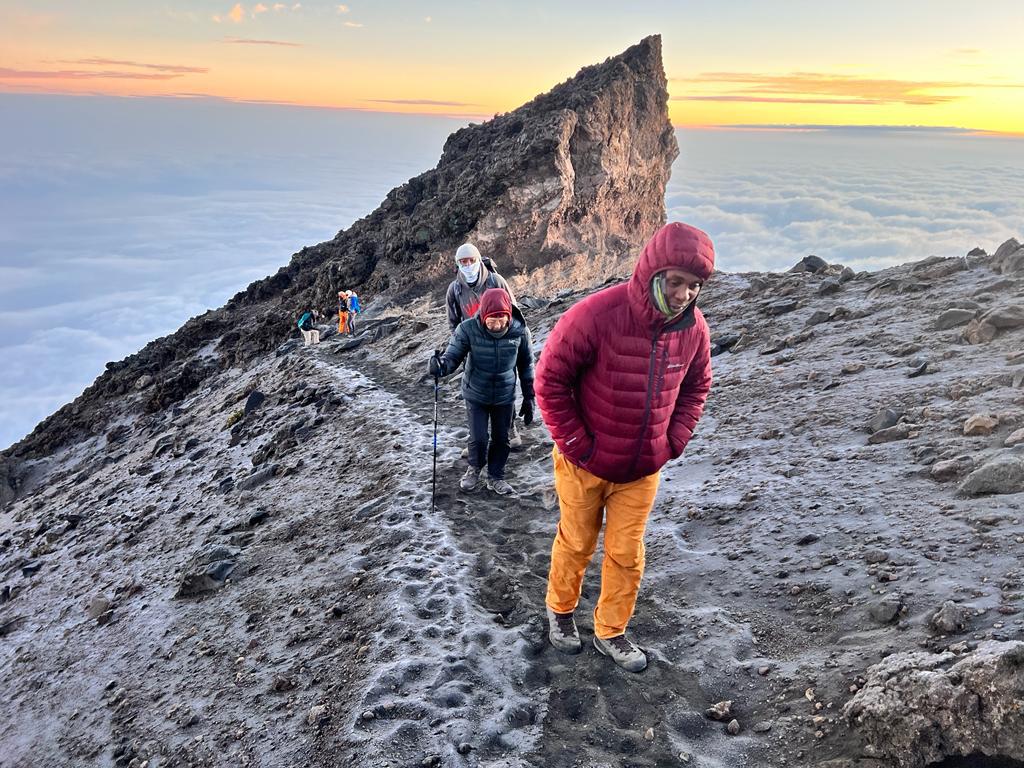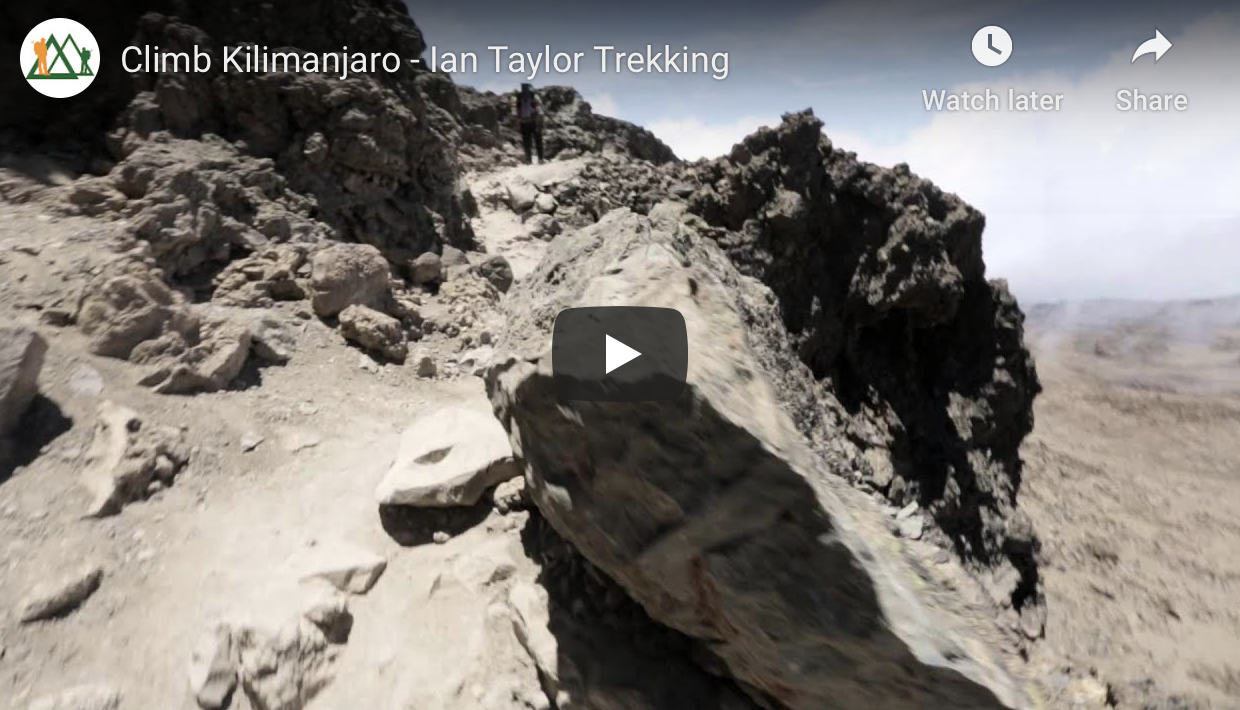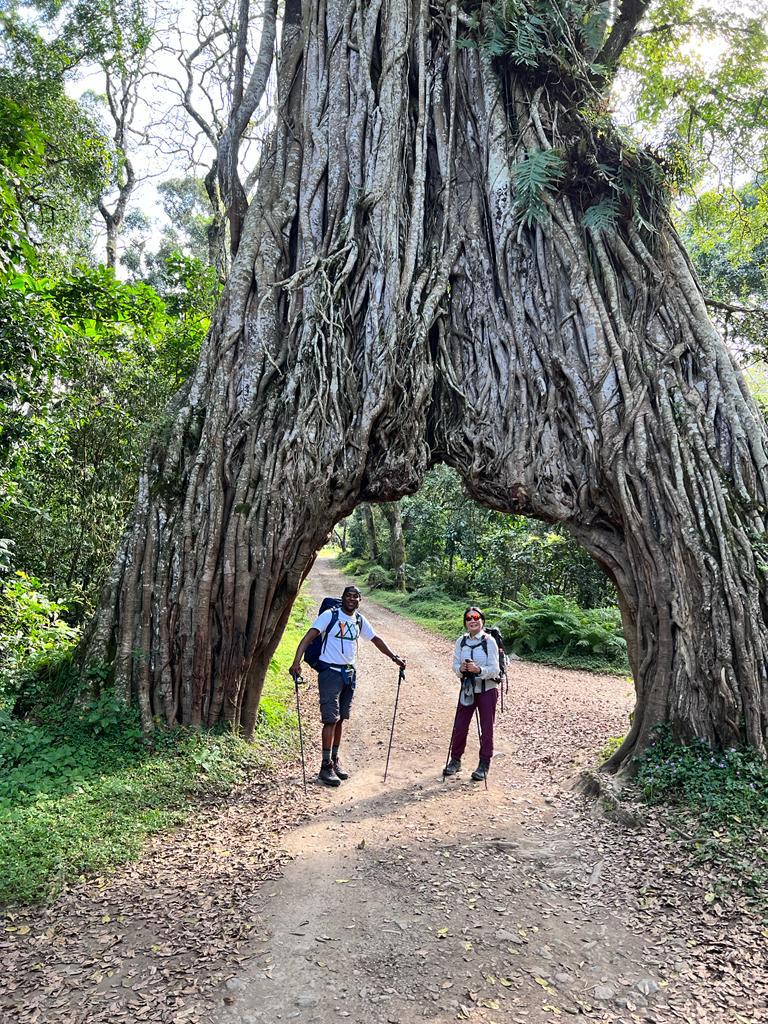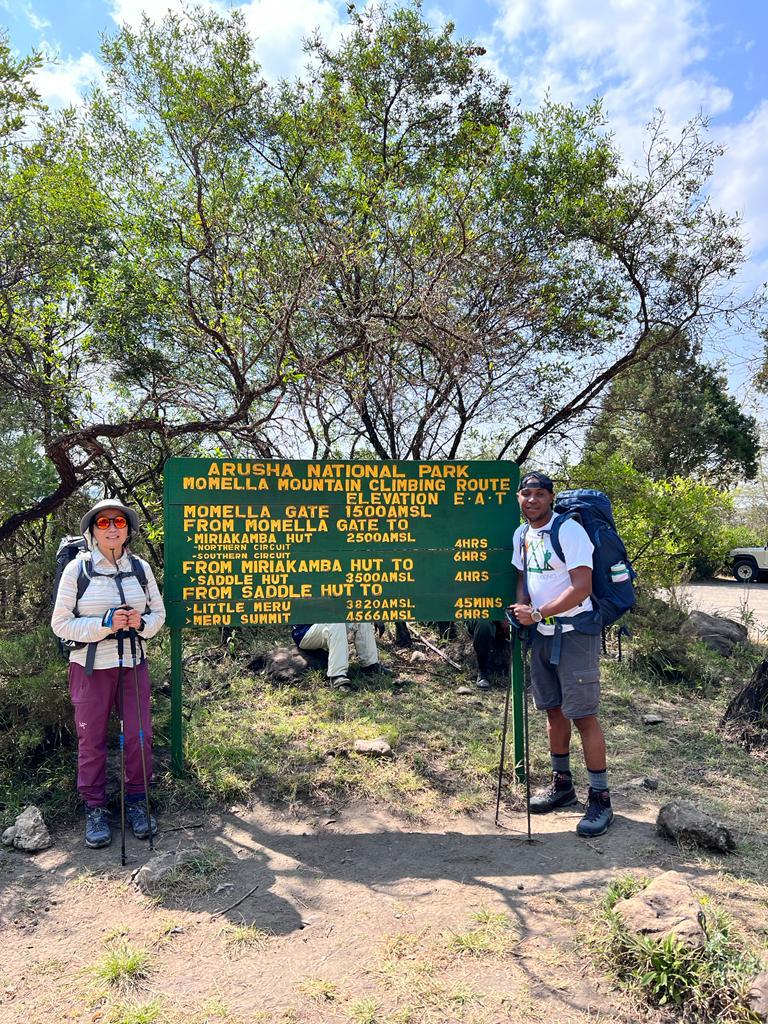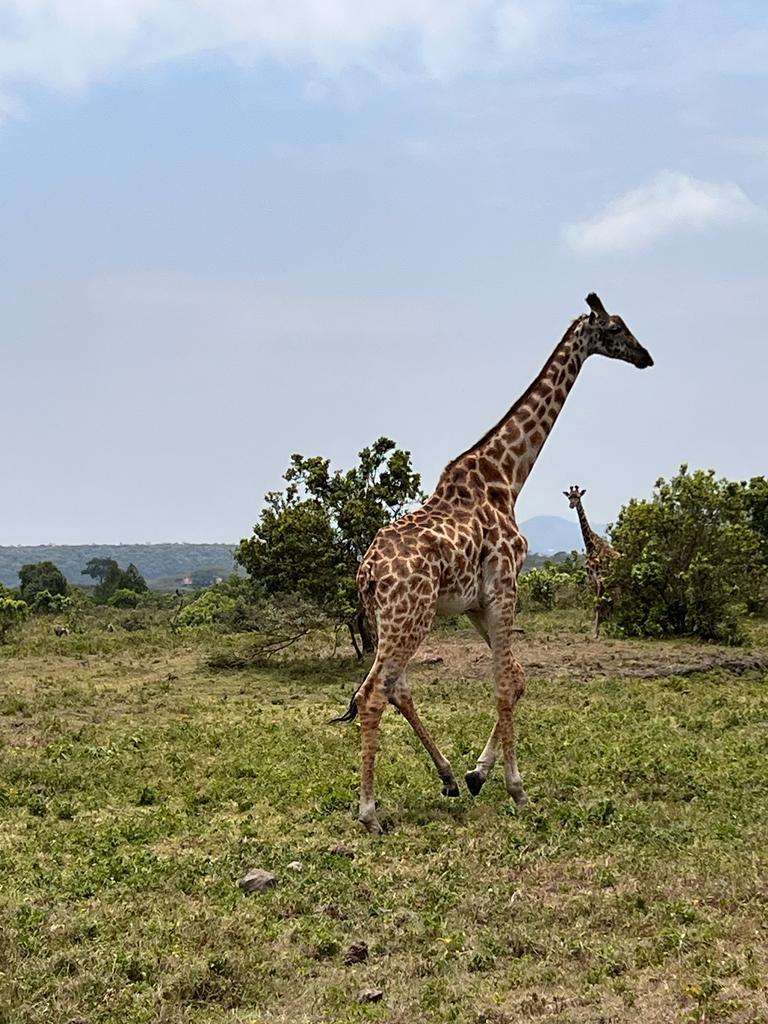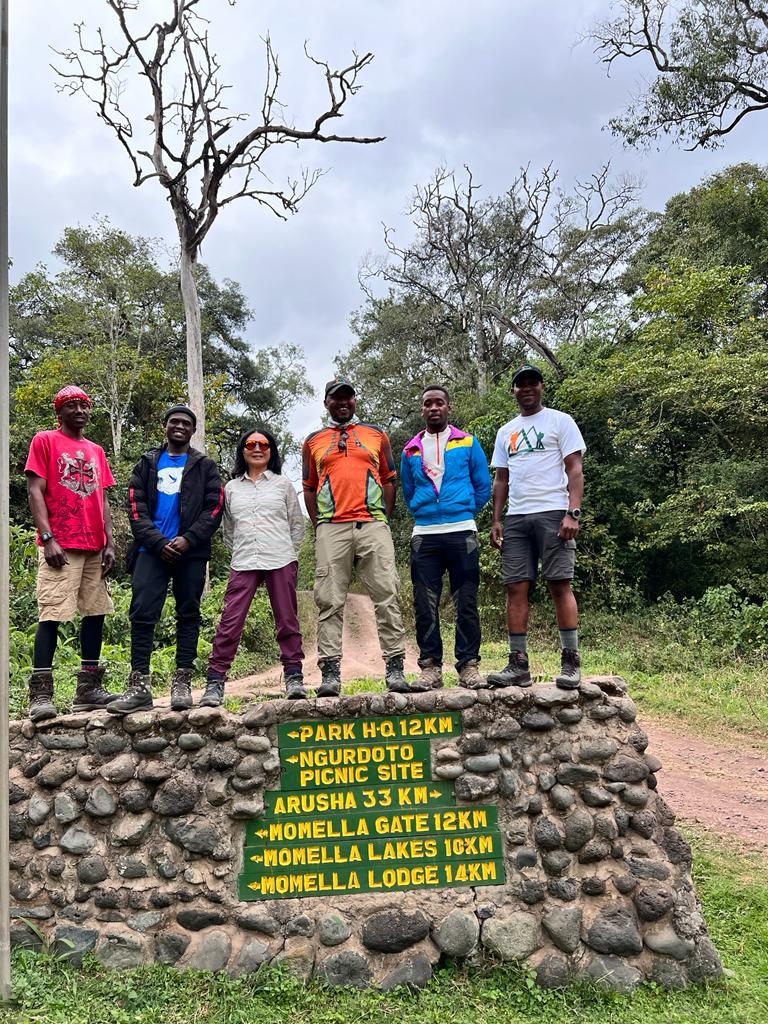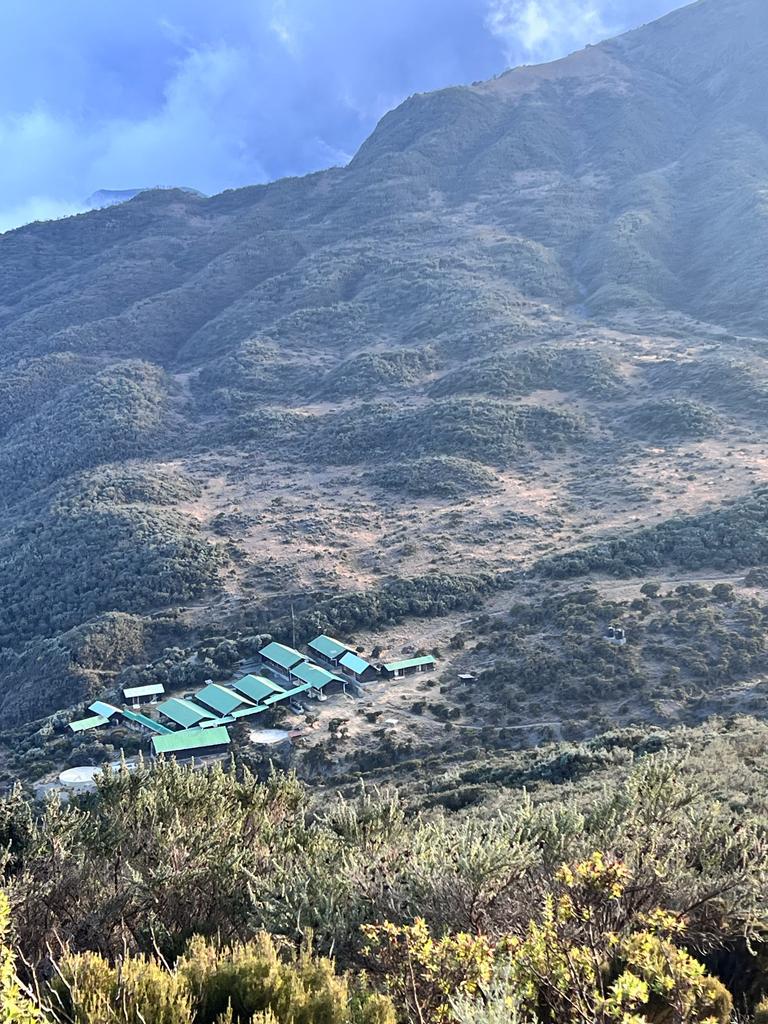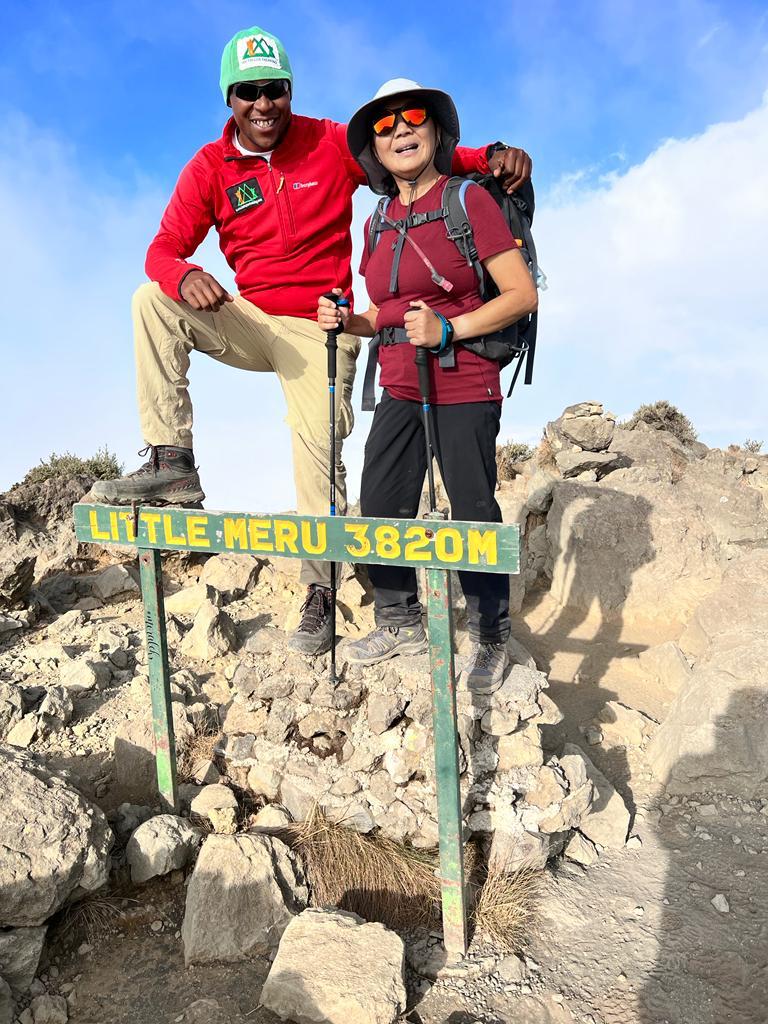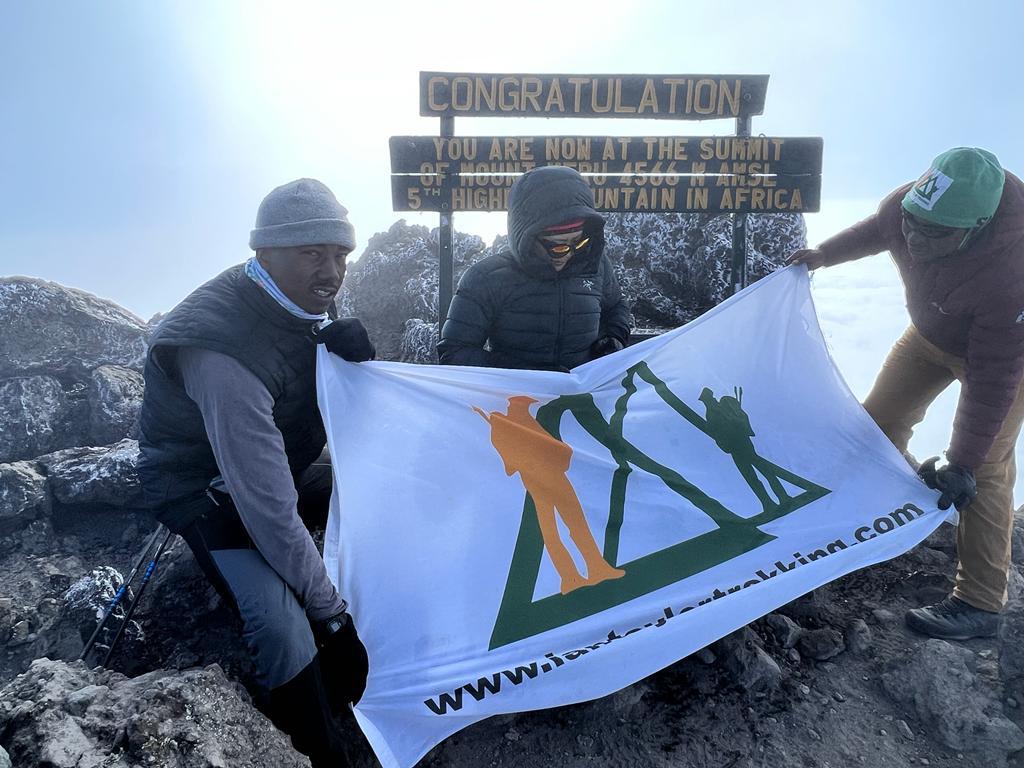Climb Mount Meru
Join Ian Taylor Trekking on the journey to Mount Meru and Kilimanjaro! We have full time and professional staff on the ground in Tanzania and are ready to help you reach your goals on Mount Meru. Our Mount Meru climbs start at $1,700.
Tips & Advice
He has done it. Our Head Guide on Kilimanjaro has been awarded Kilimanjaro Mountain Guide of the year for 2019. Athumani has been working full time with Ian Taylor Trekking now for 10 years. We are lucky to have the best staff working for us on Kilimanjaro. He has trekked to Everest Base Camp & Island peak and also has dreams of climbing Mount Everest in 2024. DONATE HERE.
Mountain Man
Furthermore, Athumani has worked hard to bring other staff with him. He coaches our team, promotes hard working team members and hand picks our team on the ground. We have invested in him and and he has invested in us! With the support of Ian Taylor Trekking, he has helped our team go to college, learn mountain skills, customer service and become mountain guides. As a result, he is well respected among his colleagues.
Business Man
With Ian Taylor Trekking funding, Athumani has also set up 3 businesses in Tanzania. A small taxi company, mini market and safari vehicle rental business. Athumani has created so many jobs for his community and family.
Family Man
Athumani, his wife Mariam and their two beautiful children have made a wonderful live for themselves in Arusha. He is a true testament to hard work, team work, persistence and doing it right, all while bringing others with him.
The Best of the Best
Athumani has proven himself to be the best of the best on Mount Kilimanjaro. He continues to show that the safety of our clients and teammates is his number one concern. Athumani has help us develop our service along with, our unique 8 day Lemosho route itinerary. Creating a safer journey up and down Kilimanjaro has been our goal and it is working. We are getting 100% success on our unique itinerary.
A Few Words from Athumani
How do you feel after winning the award: This Award means a lot to me, I feel highly recommended in my profession. After winning the award I feel more confident and I will keep working hard for my family, my country and my trekking company. Through winning the award I can raise the credibility of our company which means a lot to me.
This award will increase visibility of how we operate our quality Kilimanjaro climbs on the mountains and hopefully draw new customers. By winning this award I hope it will be a good motivator within our team. Most people who win an award are excited to share the news and I am so excited to about this award. I hope the award increases customer loyalty, by knowing that I am a skilled professional and recognized for my work, team and services we offer.
Why do I like working on Mount Kilimanjaro: I like working on the mountain because is job of my dreams. Since I was young, I was always thinking of working on the mountain and finally I found the amazing geological paradise of Kilimanjaro.
I choose the mountain because it is a physical job. It keeps me active and i stay fit mentally and physically. Also this job gives me a comfortable life and opens more doors to me, like getting a chance to visit some countries abroad.
Working on the mountain gives me a chance to meet with people from different parts of the world. I can learn from these people and they can learn from me. There is no greater gift. This makes my job so special.
After years of running trips on Kilimanjaro, we have decided to compile a list of some of the most important things we have learned. Here are our top 50 tips as you start working your way to the summit of Kilimanjaro. We have helped over 3,000 people reach the summit and have 95% success on our 8 day Lemosho Route trips.
Ian has climbed Kilimanjaro 40+ times and our head guide on the mountain was voted Kilimanjaro’s Number 1 Guide. At Ian Taylor Trekking we run over 30 quality Kilimanjaro climbs each year. We are a world leader in offering quality climbs on Mount Kilimanjaro and happy to schedule a free personal assessment with you.
You can read our Top 50 Tips here.
1). Our Team
We have our own full-time staff members on the ground in Tanzania. Our head guide was voted Best Kilimanjaro Guide in 2019. This gives us far more consistency in our service on the ground and offers you a safer and far more enjoyable experience.
2). Support the Community
We support a local orphanage, giving help and support to children in need. Why not join one of our climbs and then visit the children and brings books, toys and gifts. We also support our local team. We have also sponsored over 20 staff to go to college, some to learn English, others to become chefs and others to become guides. We have helped staff buy land and set up businesses on the ground.
3). Quality Run Trips
We only run quality Kilimanjaro climbs with more staff and better food. We use four and five star hotels in Arusha to make sure your stay in Arusha is very comfortable. Read some REVIEWS from our trips. We pay our staff correctly and we do not cut corners on any aspects of our trips.
4). Information and Advice Before your Climb
We offer personal service with training advice 5 days a week. A lot of people underestimate the Kilimanjaro challenge and, as a result, are coming underprepared. As an example, there are some long days covering over 22km with over 1,245m/ 4,085 feet of up and 2,800m/ 9,186 feet down hill, on steep terrain and at high altitude. This trip is strenuous and therefore you need specific physical strength and endurance.
5). Knowledgeable Staff
Sign up to one of our trips and you will have access to professional advice, from staff who have personally made the journey many times. Our office staff have climbed Kilimanjaro more than most people in all months of the year, therefore we are in the perfect position to help you understand the most important information in your Kilimanjaro preparation.
6). Access to Ian Taylor
Personal access to Ian and the rest of our team so we can answer all your questions. Ian has climbed Mount Everest to the top, led over 40+ Kilimanjaro climbs and led Kilimanjaro climbs on the Rongai, Marangu, Western breach, Machame and Lemosho Routes. However, most of our trips on run on the Lemosho Route because it gives the safest and most enjoyable experience climbing Kilimanjaro.
7). Building the Best Team
We have over 15 years of experience managing teams on the ground in Tanzania. As a result, this has helped us master the service and systems required to give people life changing experiences. Our head guide has been To Everest Base Camp, Island peak and the US. His goal is to climb Mount Everest and reach for the top of Everest after climbing Kilimanjaro over 260 times. Likewise, our team is well connected on the ground with access to all the key organization and authorities. All our guides and staff are passionate about the mountain, local history, culture and their home Country of Tanzania. In addition to this, our team will deliver the best and safest experience possible. We can guarantee that.
8). Safety is our Number One Concern
We carry oxygen and have fully trained medical support staff on all of our Kilimanjaro climbs. As we climb above 3,500m/ 11,500 feet and into high altitude, you need to be evaluated daily.
9). We Use Only High Quality Gear
We use quality Mountain Hard Wear tents. The tents we use are 4 person tents for sleeping and only 2 people per tent. This offers more warmth, comfort and space for you. We use Mountain Hard Wear dome tents for dining with quality chairs.
10). Two Nights in the Hotel in Arusha
We include two hotel nights at the Sheraton Hotel in Arusha, one before and one after your climb. These rooms are on a shared basis and also include breakfast! We use a range of four and five star hotels in Arusha, giving you a comfortable place to sleep before and after your climb.
11). More Comfort on the Mountain
After a long day of trekking, we want to make sure you have a comfortable spot to call home for the night! Therefore, we provide you with nice seating for your Kilimanjaro climb. Having comfortable tents to sleep in and a large mess tent to go to in the evenings, gives you a chance to sit with your teammates and enjoy the down time you have on the mountain. We want you to be in a comfortable position with as little stress as possible while on the mountain.
12). Excellent Food
We serve you three, three course meals each day on the trail. READ MORE information about our food service on our Kilimanjaro climbs. We can guarantee quality food throughout the climb. You will experience freshly made soup for lunch and dinner and we do not cut any corners. We know we need to fuel your adventure so we only serve professional grade meals each day, cooked by our amazing chefs Ede, Jumaa and Said. Furthermore, we also have 3 to 6 kitchen staff on any given trip. You will meet Nelson, Enock and Samuel. All the same staff, all the time on Kilimanjaro.
13). Excellent Chefs
We have a quality chef and sous chefs on all our treks. We have the same chefs on all our Kilimanjaro climbs and we pay them very well for their amazing work. That is why they keep coming back to work with Ian Taylor Trekking year after year. The service, food and quality are what is drawing people to our Kilimanjaro climbs. Our head chef is writing a book about the food and soups of Kilimanjaro. If you would like a copy let us know.
14). We Support the Communities we Work in
We support projects in all the areas we operate in. Above all, we want to give back to the areas that have provided for us! After Climbing Mount Everest to the summit, Ian and his climbing partner raised enough money to build the Mount Everest Primary school, which is located in the neighboring country of Uganda. In the Kilimanjaro area, we support an orphanage for children in need. In Nepal, we have built two schools and help the Goli Village Trust, which we helped establish. Ian is also aiming to climb Kilimanjaro 50 times to raise money for funds for water projects in East Africa.
15). Smaller Group Sizes
We only work with small group sizes. The maximum number of people per team will be 12 people. Most of our groups are between six and ten people, thus giving you are more personalized experience on your Kilimanjaro challenge. You can move as a team and experience more about the mountain from our staff. The only larger teams we have are when Ian Taylor is leading the team himself!
16). One to One Support Staff on the Summit
We have a ratio of 1 guide to 2 people on our trips and 1 to 1 support on the summit night. Therefore offering you a more personal service, safer experience and trip of a lifetime.
Preparation & Training
It\’s simple, if you are used to hiking and comfortable carrying a heavy backpack hiking up 1,000m/ 3,280 feet on a regular basic and training weekly and stay strong and active then you will find Kilimanjaro challenging but straight forward.
When deciding to climb Kilimanjaro, you need to consider your current ability, access to training facilities, and how much time you have to dedicate to training. All of these things will determine if you are successful on the climb. If you think running and walking on the flat with a weighted backpack are enough, you need to think again. Leg strength and endurance training in your endurance heart rate zone is important for safety and success. We can help you build a training plan.
The Two Main Factors
Firstly, In my opinion you need a minimum of 8 days on Kilimanjaro. Taking eight days on Kilimanjaro will give you the best acclimatization process and the best experience possible. Climbing Kilimanjaro is truly one of the great trekking experiences. So why not spend more days on the mountain to get the most out of your experience. I know it costs more, but you will come away with a much richer experience.
Secondly, you need to make sure that you are coming with the right training and preparations. We are available 5 days a week, to make sure you are getting the best information on the climb. We want to make sure that you have the tools to be safe and successful.
The Long Descent Down Kilimanjaro
Think about the elevation gains and lack of oxygen so you can build the correct training plan.
Day 1: Hike from 7,545 feet to 9,186 feet
Day 2: Hike from 9,186 feet to 11,500 feet
Day 3: Hike from 11,500 feet to 13,123 feet. Sleep at 12,795 feet
Day 4: Hike from 12,795 feet to 15,223 feet down to 12,795 feet
Day 5: Hike from 12,795 feet to 13,780 feet up and down to 13,123 feet
Day 6: Hike from 13,123 feet to 16,076 feet
Day 7: Hike from 16,076 feet to 19,341 feet back down to 10,170 feet
Day 8: Hike from 10,170 feet to 5,577 feet
When you think about these elevation gains and long steep descents you need to review the daily distances, elevations gains up and down. Consider the incline on ascent and descent and think how you train for low oxygen environments. We can help you understand the key elements to this and how you can map out a training plan for climbing Kilimanjaro.
Hiking up and Down Hills is the Best Training
Hiking up and down hills with weight is by far the best training you can do. Try to build up from 3 hour to 8 hour hikes once a week. Taking regular and increasingly longer hikes will help develop the muscles that you need when you arrive on the side of Kilimanjaro. This can not be on the flat. You need to trying to gain 500m/ 1,640 feet, building up to 1,000m/ 3,280 feet ascents and descents. However, very few people are lucky enough to have access to hills every weekend. Try to find some local hills or stairs to walk up and down if possible. Gradually increasing the duration of your walks will help to develop your stamina and also assist in preparing you for being on your feet over long distances.
When out on training hikes, ensure that you always wear the boots you intend to take to Kilimanjaro. Getting used to and breaking in your trekking boots will assist in making you as comfortable as possible on your climb. It is also good to train in the same backpack you will be taking with you on the climb. This will help you feel at ease with it and gradually add weight to the pack to build strength. Building up gradually from 6kg/ 13lbs to 12kg/ 26lbs over a 6 month period. Learn more.
Not everyone will have access to hills, but this is the best way to train your body and legs for down hill hiking. Depending on your chosen adventure you do need to assess the level of downhill. We have elevation gains available for all of our key trips. I encourage you to review the daily elevation drops and what type of terrain you will be walking on.
For example, on our Inca trail treks you will be drop 700m/ 2,296 feet to 1,000m/ 3,280 feet on different days all on steep rocky stairs. On Kilimanjaro you will drop 2,800m/ 9,186 feet in one day on scree and rock and this is very challenging on your legs and joints.
You have just walked for days on end you have reached your goal but not you have to retrace your steps, often in a quicker time frame. Hiking downhill will take its toll on your joints. Fore sure, the downhill hike will take more wear and tear on your joints and muscles than the uphill.
You do need to use effective training techniques to minimize the impact on your body. Descending using good technique means that you move faster and feel lighter. Remember, 80% of accidents happen on the way down.
Keeping Knees Healthy
We live in Eagle-vail Colorado with amazing access to altitude and a wide range of mountain terrain to train on. In Colorado we can train all year round on hilly terrain preparing for Kilimanjaro, Himalayan trekking and mountaineering trips. I know most of you are joining our trips from sea level and with minimal access to hill training. I encourage you to get out to Colorado doing some multi-day hiking in preparation for your chosen adventure.
If you do not have access to hills and mountains, you must figure out other ways to prepare your knee joints to handle downhill stress. From a knee perspective, downhill hiking means eccentric loading and typically thousands of repetitions of it. Eccentric loading (the lengthening phase of a contraction) is especially challenging to what is called the patellofemoral joint of the knee. This is where the knee cap, meets the femur. Inadequate strength, poor mechanics and lack of exposure to this type of loading can turn downhill forces into injury producing stress. Prior to your trekking trip you need to start implementing sport specific training into our general preparedness programming.
Hiking Uphill and Downhill
Hiking uphill is all concentric muscle action (muscle active while shortening) at the knee joint without any eccentric loading (loading while muscle is lengthening). Concentric only exercises tend to cause less mechanical stress, load and pain to joints and tendons than do exercises that have eccentric phases. What goes up must come down.
You must prepare our body and specifically your knees to handle downhill hiking. Depending on the trip, you really need 6 months of some sport specific training into our general preparedness programming.
The strength movements below are similar but slightly different in specific ways. We purposely only hit each one once per week because too much volume of these exercises could quickly lead to an over training injury, so be careful. I would recommend adding in additional hip flexor and quadriceps mobility work at the end of your training sessions as well to maintain good length tension relationships and to protect your spine.
The Point of These Exercises
Increase vertical loading volume of the knees with a sight posterior to anterior (back to front) force vector. Get exposed and accustomed to decelerating the vertical and forward forces using primarily a knee strategy. Transition from doing most lunges and squats with a 3 points of contact foot position to a more heel elevated position where we contact and press through the forefoot.
The 3 points of contact foot position is the most stable position for the foot and encourages a balance of hip and thigh musculature – great for general preparedness training. Transitioning to a heels elevated position where the forces are applied through the forefoot places most of the stress on the quadriceps and knees – optimal for downhill hiking training.
Exercises for Downhill Hiking
You should consider adding these movements into your weekly training 2 times per week. Add 3-5 sets of 10-15 repetitions (per leg)
1). Heels Elevated Goblet Squat
2). Forward Alternating Lunge with Farmers Carry Loading
3). Forward Alternating Drop from Box Lunges
4). Banded Posterior to Anterior (PA) Forward Lunges
Carrying Weight
One of the best ways of mitigating the risk of musculoskeletal issues is by carrying a light pack. Then build up the weight you carry over time. An overly heavy backpack is not recommended in the early stages of your training.
Extract its biggest toll on your body during steep and/or long downhill sections, so a hiker should always aim to travel as lightly as the dictates of their skillset and the environment into which they are venturing allow.
If you are carrying weight on longer hike you should slowly build up the weight you carry. You should also consider carry water uphill and dump as much water/ weight as possible for your downhill. Always assess the weight you are carrying for each hike and always build up slowly over time. You do not want to get injured.
Our Unique Itinerary
Day 1 - Arrive at Kilimanjaro International Airport
You should aim to arrive as early as possible this day or you are welcome to arrive in earlier if you choose. Once you arrive, you will be picked up from the airport and taken on a 50-minute transfer to the hotel in Arusha, where you will be booked on a shared bed and breakfast basis. You will have a group briefing in the evening with our head guide to prepare you for the journey ahead. Our head guide was named the Mountain Guide of the year in 2019 on Kilimanjaro and you can read more about him here: https://iantaylortrekking.com/blog/kilimanjaro-mountain-guide-of-the-year-2019/
Day 2 - MIRIAKAMBA HUT 2,515m/ 8,250 feet
After breakfast at the Sheraton hotel, our local team will be there to pick the team up to start the journey! Normally, the meeting time will be 8am, but this will be confirmed at the briefing the night prior. Time to drive to Momella gate in Arusha National Park for
registration at entrance gate. Start climb with your guides and armed ranger, crossing open plains filled with buffalo and giraffe before climbing up through Montane Forest, replete with the calls of Colobus Monkeys and Hornbill to Miriakamba Hut, on the lip of Meru crater. Dinner and Overnight at MIRIAKAMBA HUT (BLD)
Day 3 - Saddle Hut 3,570m/ 11,713 feet
An early start to admire sunrise over distant Kilimanjaro before walking into Meru Crater for a foot safari amongst the primeval landscape and looming 200 feet high walls that lead up to the summit. We then continue our climb via the ‘Little Meru’ outcrop to Saddle Hut, located on the ridge that climbs up to the summit of Mount Meru 4,566m/ 14,980 feet. Dinner and Overnight
at SADDLE HUT (BLD)
Day 4 - Miriakamba Hut 2,515m/ 8,250 feet
You will be awaken in midnight and start with your guide leading the way up the occasionally - narrow ridge that falls away to the Crater below, arriving at the summit of Mount Meru as the sun rises. After summit we descend the same ridge as the wind begins to pick up, passing Saddle hut to Miriakamba for a celebration dinner and a well-earned rest. Dinner and Overnight at MIRIAKAMBA HUT (BLD)
Day 5 - End of Mount Meru climb
We finish the walk and arriving at Momella Gate 1,500m/ 4,920 feet. You collect your certificate
and then head for a game drive around Arusha NP then heading back to Arusha.
Day 6 - Safari or Airport Transfer
Today will be spent at leisure in Arusha. You can decide to sit by the pool at the hotel or exploring the town of Arusha. We will transfer you back to the airport to catch your international flight home. There is also an option for you to stay on in Tanzania and do one of our Safari options, sampling some of the world’s most unique wildlife.
Addons
On Monday, the 23rd of March, 2009, Graham Kinch and Ian Taylor officially opened the Mount Everest Primary School in Kitandwe, Uganda. Graham and Ian climbed Mount Everest in the spring of 2008 to raise money for the Kitandwe School Project in partnership with Fields of Life. This concluded a three-year project in which they climbed 4 mountains on 4 continents to build the school. They raised $100,000 for the school and continue to support its future.
The school consists of two blocks totaling seven classrooms and an office, toilet facilities, teachers accommodation, Kindergarten block and a bore-hole pump supplying water to over 600 villagers. The school also doubles-up as a multi-purpose community building.
An appropriate support structure of a Board of Management, trained teachers, a Principal, a PTA, and official curricula, etc., is already in place. In 2013, the Mount Everest Primary was number one in it’s district.
Continuing Support
This support structure will ensure this investment will be fully and effectively utilized. The school has 240 pupils in classes at present and hopes to expand. A small group from one of our Kilimanjaro trips raised money to help build a new Kindergarten building. We have 40 children sponsored through Fields of life child sponsorship, we currently need a further 48 child sponsors in our school. Click here to find out more.
Sponsor a Child
With most forms of integrated development aid, a two-pronged approach is planned.
The fundraising has successfully provided the required capital to build the school. Now child sponsorship is required to keep the school running. We have 40 children sponsored, but we still need 48 child sponsors as of April 2020. Contact us for further information or contact Fields of Life directly.
Visit the Mount Everest Primary School
On your visit you will experience village life in Uganda and see how they cut a living from their environment. We will sample the local food, play football with the kids and experience the way of life in rural and urban Uganda. We will also add in a visit to the Equator before leaving this beautiful country. This is one trip that may chance your perspective maybe even your life. We can only organize this trip for a group of 4 or more people.
New Goals
If you are interested in raising money for the continued support of the village please let us know. I have a goal of Climbing Kilimanjaro 50 times in support of water projects in East Africa. We would like to raise $1,000,000 and bring clean water to thousands of people over the next 10 years.
We have our own safari vehicle to take you on any safari in Tanzania. Whatever you do you need to have Ngorongoro crater as part of your itinerary. We guarantee it will not disappoint, explore the Serengeti, climb a live volcano and visit Tarangire national park. We have them all rolled into our top class safari’s in Tanzania.
Why choose one of our Safari’s
You have completed your Kilimanjaro climb on one of our world class treks with the best guides on Kilimanjaro. Now you can relax and explore Tanzania without long hikes, altitude and tents. We use comfortable lodges with excellent food and service. We have our own full equipped Safari Vehicle. Our highly experienced safari guides know each park, where the animals are located and help you learn more about these unique regions in Tanzania. They are more than happy to help you experience the natural beauty of Tanzania in a relaxed and serene environment you will never forget.
Itineraries
Tarangire, Lake Manyara & Ngorongoro crater
This itinerary is designed for a more activity safari lover. This is more for someone who wants to experience the real landscape of Africa. We climb a live volcano and visit old ruins and experience lake Natron and it’s baron and desolate landscape.
Ngorongoro and Serengeti National Parks
This itinerary is designed with everything in mind. There is an infusion of the very best of Tanzania. You will Three of the best wild life parks in the world. The Serengeti, Ngorongoro crater, Tarangire National park. We have the Eight Wonder of the World. This is our true wildlife safari giving you the big five in the best safari destination on the planet.
Ngorongoro Crater and Lake Natron Camp
We have a fusion of world class safari parks along with exploring a live volcano and visiting the 1.8 million old Olduvai gorge and the source of humanity. This is our favorite and action packed itinerary. If you want the best of the best in Tanzania this is for you. You will not be disappointed. I highly recommend this itinerary as you will be left amazed, stunned and inspired on this quality Tanzanian Safari.
One Day Safari to Tarangire National Park in Tanzania
Tanzania has the best game viewing in the world
You will experience Africa’s world class wild life parks. The Serengeti and Ngorongoro crater really are the best National parks in Tanzania if not in the world. Witnessing animals deep inside their natural habitat in the ‘Eight Wonder of the World’ will leave you with a greater appreciation of the natural world. We have added in a hike up a live volcano and trip to the source of humanity in Olduvai gorge. We can also tailor safari itineraries to your needs, so get in touch today and lets plan your safari today. Our safari’s are an ideal relaxing experience after climbing Kilimanjaro.
3/4 Days Gives you the Very Best Safari Experience
Click on our itineraries below and check out what is on offer and check out the quality accommodation we offer you. We are available 5 days a week to help you work through every aspect of your chosen itinerary. We want to make sure you are fully prepared for this journey into the wild.
Equipment
Once you have signed up to one of our Kilimanjaro climbs, then we will send you our 35 page trip Dossier. The Dossier includes an itemized kit list, training advice and other relevant information to help you come fully prepared to Tanzania.
Chat With the Experts
We are your best resource for getting the right gear for your climb of Kilimanjaro and will be available to you 5 days a week to assist you. If you want to have the best experience on Kilimanjaro, then GET IN TOUCH today.
FAQ\'S
Q). Can we leave baggage and do laundry at the hotel?
A). We use the Sheraton hotel in Arusha and they have a secure room for baggage that you need to leave at the hotel. The hotel has a laundry service.
Q). Is it difficult to climb Kilimanjaro?
A). The question how difficult is it to climb Mount Kilimanjaro is a very tough one to answer! If you are used to hiking long distances weekly covering 1,000m/ 3,280 feet, carrying your backpack with weight. Along with, training 5 days a week and in good physical conditioning. You might find it straight forward. Also you have 8 days on the mountain, this gives added acclimatization and safety. We use Kosovo Camp at 4,900m/ 16,076 feet which helps on the long and challenging summit night. Learn more.
Q). What are the best months to trek Mount Kilimanjaro?
A). Traditionally, the weather on Mount Kilimanjaro is fairly predictable. Kilimanjaro has dry seasons and rainy seasons. Some months have more sun, some months have to more cloud cover and other months are colder than others higher on the mountain. We highly recommend January, February, June, July, August, September, October and we like a New Year trip from December into January. Learn more.
Q). How difficult is the Barranco wall?
A). A lot of people have fears when it comes to the Barranco Wall. However, the truth about the Barranco wall is that 95% of this infamous place on Kilimanjaro is just slow walking. There are just a couple of scrambling sections on the lower and upper most part of the wall. They do not require any technical experience, just a bit of extra focus, good balance and core stability. Learn more.
Q). What will the food be like on Kilimanjaro?
A). Every company is different. We only run Kilimanjaro tours to the high quality. We only serve hot meals each day with 3, 3 courses meals a day on Kilimanjaro. Learn more.
Q). How much is the visa fee to enter Tanzania?
A). Right now the visa fee ranges from USD $50 to $100. For US clients it is $100, while most European countries will pay $50.
Q). What vaccinations do I need to enter Tanzania?
A). Tanzania does NOT have Yellow Fever in the country, so they only require you to show proof of vaccine for Yellow Fever if you are from a country that does have Yellow Fever. Or transiting for more than 12 hours in an airport located in a country with risk of Yellow Fever Virus transmission. Here are some recommended for vaccinations entering Tanzania: Tetanus, Hepatitis A, Typhoid, Hepatitis B, Poliomyelitis, Cholera, covid19 and tablets to protect you from getting malaria. Learn more.
Q). How much does it cost to climb Kilimanjaro?
A). After putting over 3,000 people on the summit we have developed a quality system and unique itinerary for a successful Kilimanjaro Summit. If you want to give yourself the best chance of success you will be paying $400 to $500 per day to have 35+ quality staff, quality tents, equipment, safety equipment, quality food and all the systems in place. So, for a 7 day Machame route tour you will pay anywhere from $2,500 to $4,000 including airport pick up and drop off and hotel nights on either side of the trip. For a 8 day Lemosho route climb you will pay anywhere from $2,900 to $4,500 depending on the hotels, service the company offers prior to the climb. If you have a western guide it can cost even more. Remember 8 days on the mountain gives you the best and safest chance of standing on the summit. Learn more.
Q). What additional expenses will I incur?
A). Here are some additional expenses that you will incur. Visa Entry, meals in Arusha, Tips, laundry, souvenirs, insurance, helicopter evacuation cover.
Q). How much should I tip the staff and can I give individual tip for the porter who carried by backpack?
A). We recommend tipping the staff as a group on the last morning of the trip in Mweaka Camp before descending to the gate. The tips can be given to Athumani or Head Guide and they will distribute to the Dream Team. We recommend $300.
Q). What insurance do I need to have?
A). We recommend having Global Rescue Helicopter evacuation along with their or any insurance that covers trip cancellation cover, repatriation along with medical expenses.
Q). What challenges will I face climbing Kilimanjaro?
A). You will possibly experience rain, wind, hot, cold temperatures all in one week. High UV levels from the sun, so stay covered up. The higher realm of Kilimanjaro sits in Extreme altitude. The biggest summit day of your life! Going up 1,000m/ 3,280 feet from Kosovo Camp to the summit and back down to Mweka Camp. Possible physical fatigue, depending on physical preparation. You will not sleep as well as you would at home. It can be challenging to sleep in a sleeping bag and tent if you have experience doing that. Learn more.
Ready to go?
The Ian Taylor Trekking office team have climbed Kilimanjaro over a combined 50 times. Our Head guide was voted Kilimanjaro\’s Number 1 Guide. We have the knowledge, team and experience delivering the safety and best experience on Kilimanjaro.
We are here with the information you need to be successful. Get in touch today for more information on climbing Kilimanjaro on the Lemosho Route.


